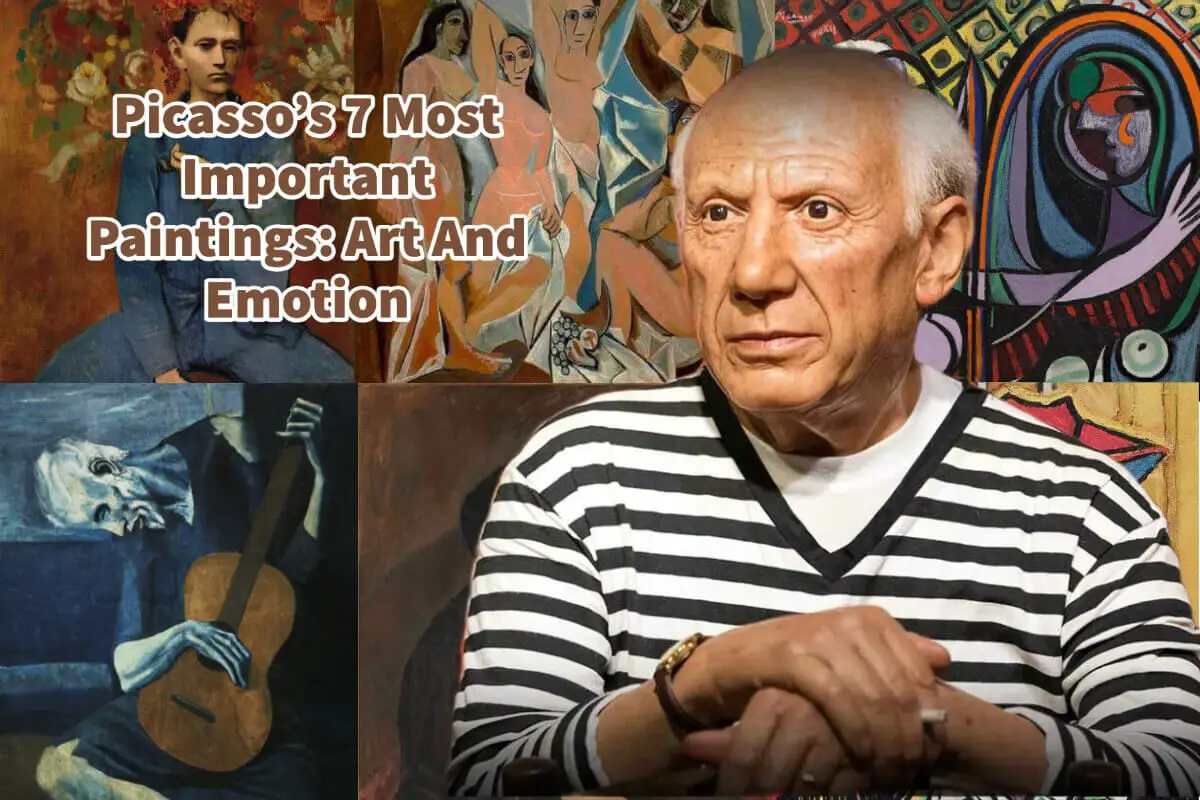Pablo Picasso continues to be one of my favorite artists. His art is filled with emotion and messages.
Pablo Picasso painted many important paintings during his lifetime as an artist. But seven of us most important “The Old Guitarist,: “Boy With a Pipe, and his more famous painting “Guernica”. Read on as we explore each of these seven more important paintings and why they are considered to be such significant works of art.
Table of Contents
- Pablo Picasso’s 7 Most Important Paintings: A Journey Through Art And Emotion
- The Blue Period (1901-1904) “The Old Guitarist” By Pablo Picasso
- The Rose Period (1904-1906) “Garçon à la Pipe (Boy With a Pipe)” By Pablo Picasso
- Breaking New Ground “Gertrude Stein” – By Pablo Picasso
- Pioneering Cubism “Les Demoiselles d’Avignon” By Pablo Picasso
- Exploring Identity and Perception “Girl Before a Mirror” By Pablo Picasso
- Confronting The Horrors Of War “Guernica” By Pablo Picasso
- Emotional Aftermath “The Weeping Woman” By Pablo Picasso
- Pablo Picasso’s Artistic Style And Experimentation
- Frequently Asked Questions
- Related Questions
Pablo Picasso’s 7 Most Important Paintings: A Journey Through Art And Emotion
Pablo Picasso, one of the most influential artists of the 20th century, left an indelible mark on the world of art. His innovative approach, diverse styles, and profound emotional expression continue to captivate audiences today.
Read on as we explore Picasso’s seven most important paintings, each representing a significant period and theme in his artistic journey. From the sorrowful beauty of “The Old Guitarist” to the powerful anti-war statement of “Guernica,” we will delve into the stories behind these iconic artworks.
The Blue Period (1901-1904) “The Old Guitarist” By Pablo Picasso

The Old Guitarist – Completed: Late 1903 to early 1904,
Where to see it: Art Institute of Chicago
“The Old Guitarist” is a testament to Picasso’s blue period, when he explored themes of poverty and suffering. The painting portrays a gaunt figure slumped over a brown guitar, exuding an aura of exhaustion and melancholy.
This oil-on-panel artwork captures the somber atmosphere with its restricted palette of blues. Located at the Art Institute of Chicago, this painting evokes a profound empathy for the human condition.
The Rose Period (1904-1906) “Garçon à la Pipe (Boy With a Pipe)” By Pablo Picasso
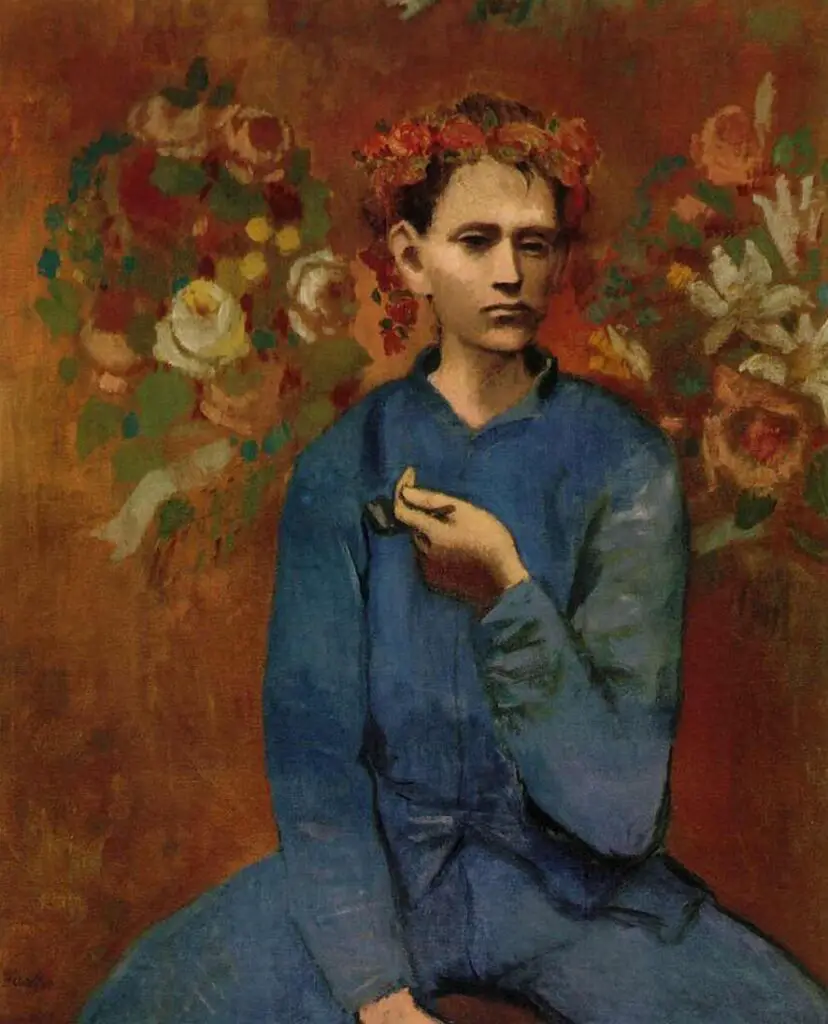
“Garçon à la Pipe (Boy With a Pipe)” – Completed: 1905,
Where to see it: – Held by a Private collection
Transitioning from the Blue Period, Picasso embraced a more lively color palette in his Rose Period. “Garçon à la Pipe (Boy With a Pipe)” showcases a young boy adorned with a headpiece of flowers against a background of ochre and pink hues. Painted shortly after Picasso moved to Paris, this oil-on-canvas masterpiece reflects the influence of the artistic atmosphere in Montmartre during that time.
Breaking New Ground “Gertrude Stein” – By Pablo Picasso

“Gertrude Stein” – Completed: 1905-06,
Where to see it: Metropolitan Museum of Art (New York)
In “Gertrude Stein,” Picasso depicts his close friend, an influential writer and art collector. This portrait is created towards the end of his rose period, showcasing Picasso’s shift towards a more abstract style.
Though not yet fully cubist, this work exhibits the early stirrings of the groundbreaking art movement. The Metropolitan Museum of Art in New York houses this imposing portrait, demonstrating the connection between art and literature during that era.
Pioneering Cubism “Les Demoiselles d’Avignon” By Pablo Picasso
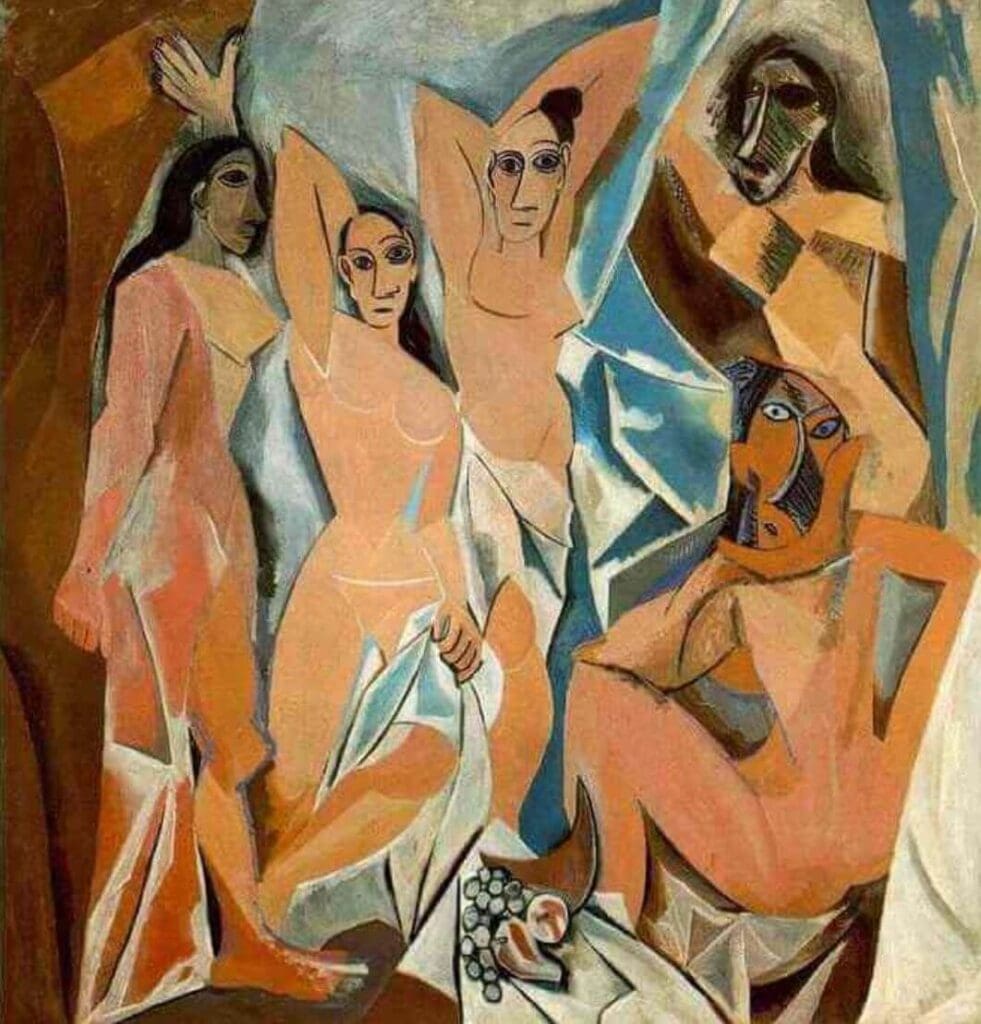
“Les Demoiselles d’Avignon” – Completed: 1907,
Where to see it: Museum of Modern Art (New York)
“Les Demoiselles d’Avignon” marked a turning point in modern art. This revolutionary painting shocked the art world with its subject matter—a group of women in a brothel—and the distorted, fragmented forms inspired by cubism.
Painted in 1907 but not exhibited until 1916, this provocative artwork remains one of Picasso’s most recognizable masterpieces. Displayed at the Museum of Modern Art in New York, it continues to challenge conventional artistic norms.
Exploring Identity and Perception “Girl Before a Mirror” By Pablo Picasso
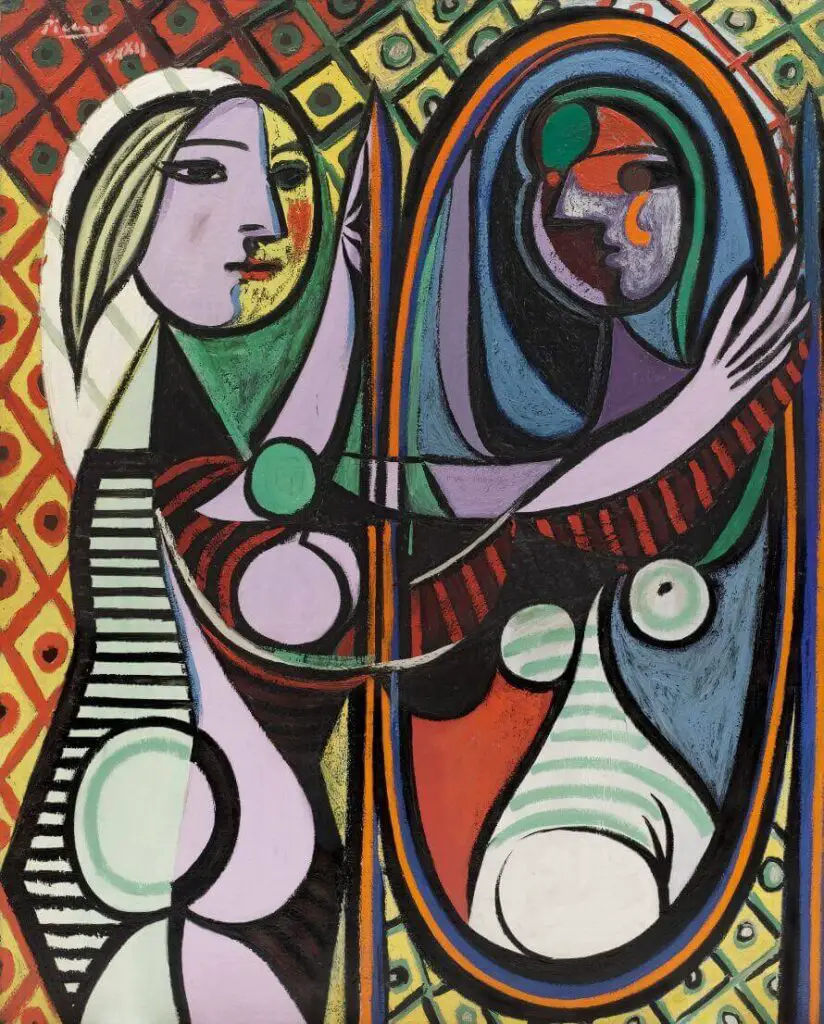
Girl Before a Mirror” – Completed: 1932,
Where to see it: Museum of Modern Art (New York)
If there is one painting that epitomizes Picasso’s style, it is “Girl Before a Mirror.” This vibrant artwork pushes the boundaries of cubism with its complex shapes and intense colors. It presents a thought-provoking exploration of self-perception, depicting a woman observing herself in a mirror.
The Museum of Modern Art in New York houses this captivating piece that showcases Picasso’s ability to merge emotion and form.
Confronting The Horrors Of War “Guernica” By Pablo Picasso
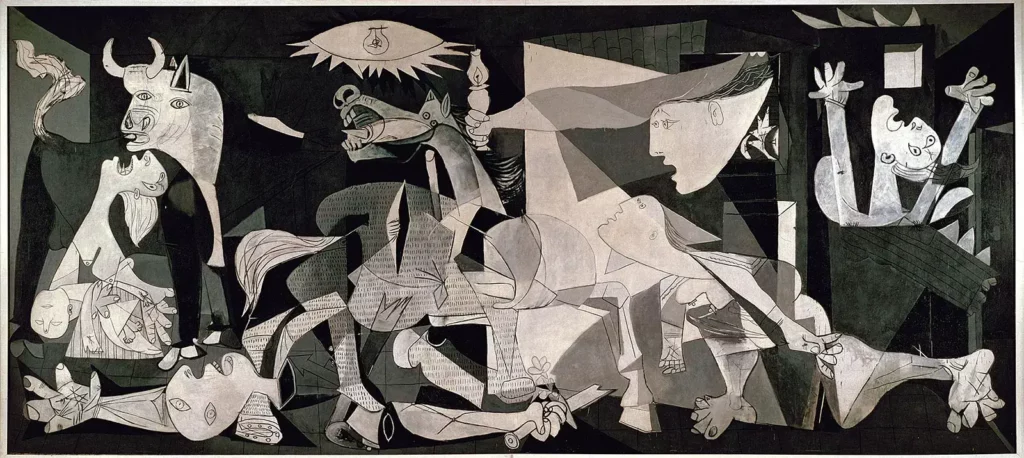
Guernica”- Completed: 1937,
Where to see it: Museo Reina Sofía (Madrid)
“Guernica” is undoubtedly Picasso’s most famous and impactful work. Depicting the devastating aerial bombing of Guernica during the Spanish Civil War, this monumental painting serves as a haunting reminder of the horrors of war.
Created in a monochromatic palette of muted grays, “Guernica” showcases distorted and anguished human figures and powerful symbols like the bull and the horse, which are deeply associated with Spanish culture.
Housed at the Museo Reina Sofía in Madrid, this painting has become an enduring symbol of anti-war sentiment.
Emotional Aftermath “The Weeping Woman” By Pablo Picasso
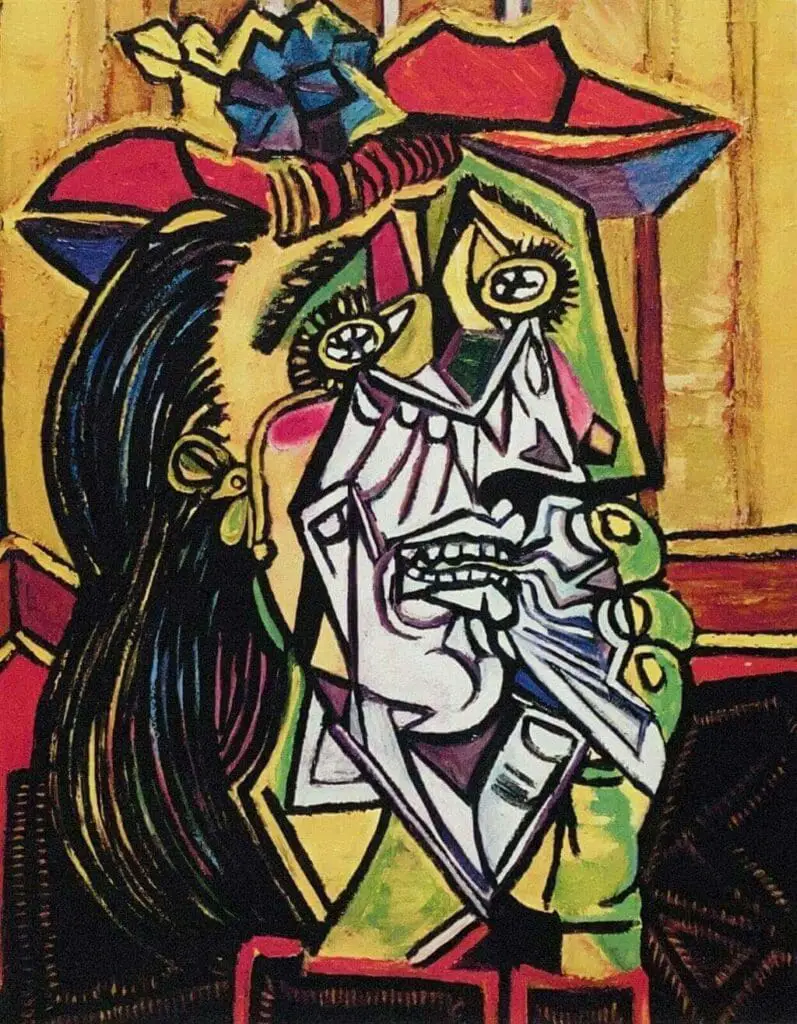
“The Weeping Woman” – Completed: 1937,
Where to see it: Tate Modern (London)
Considered a sequel to “Guernica,” “The Weeping Woman” explores the emotional aftermath of war through the eyes of a grieving woman. Picasso created a series of weeping women portraits, and the version displayed at the Tate Modern in London represents the culmination of this exploration.
Executed in his distinctive angular style, the oil-on-canvas painting combines vibrant colors and expressive brushwork to convey anguish and sorrow. It serves as a poignant reminder of the long-lasting impact of conflict on individuals and communities.
Pablo Picasso’s Artistic Style And Experimentation
Picasso’s artistic journey was marked by constant experimentation, innovation, and a deep connection to the human experience. From the somber tones of his blue period to the revolutionary developments of cubism, his paintings continue to captivate viewers worldwide.
Through his art, Picasso explored themes of suffering, identity, and the consequences of war, leaving a profound impact on the art world and beyond.
Picasso’s ability to evoke powerful emotions through his brushstrokes and subject matter sets him apart as a legendary artist. His works, such as “The Old Guitarist,” “Les Demoiselles d’Avignon,” and “Guernica,” transcend their physical form and become vehicles for social commentary, self-reflection, and collective memory.
In the words of Pablo Picasso himself:
“Art is the lie that enables us to realize the truth.”
Pablo Picasso
Through his paintings, he sought to uncover deeper truths, challenge established norms, and invite viewers to confront uncomfortable realities.
Picasso’s seven most important paintings we showcased are a testament to his artistic genius, his profound impact on the art world, and his enduring legacy as a visionary and master of his craft.
Anita Louise Art is dedicated to art education, great artists, and inspiring others to find and create their art. We love art that uplifts and inspires. #ArtToMakeYouSmile! #ArtToMakeYouHappy!
If you want to see any of my art, you can find out more by clicking here. If you are interested in what inspires me and my paintings, you can discover more by clicking here.
We have a free newsletter and would love you to be part of our community; you can subscribe to the newsletter by clicking here. If you have any questions, I would be happy to talk to you. You can reach me, Anita, by clicking here.
Subscribe to our Anita Louise Art YouTube Channel filled with great videos and information by clicking here.
Join us for our podcast “5 Minutes With Art.” Spend 5 minutes a week with us to discover and learn about great art and artists. You can find out more about our podcast by clicking here.
Frequently Asked Questions
What makes Picasso’s paintings so emotionally powerful?
Picasso’s mastery of artistic expression lies in his ability to convey complex emotions through innovative techniques, vibrant colors, and distorted forms. His unconventional approach to art evokes strong emotional responses from viewers.
Why is “The Old Guitarist” considered one of Picasso’s most important paintings?
“The Old Guitarist” is hailed for its profound depiction of human suffering and solitude. The blue tones and elongated figure of the old man resonate with a deep sense of melancholy, showcasing Picasso’s unique ability to convey raw emotion.
What is the significance behind “Boy With a Pipe”?
“Boy With a Pipe” is celebrated for its innocence and charm. Picasso brilliantly captures the purity of youth through the portrayal of the young boy. The juxtaposition of the boy’s youth against the darker backdrop emphasizes the fleeting nature of innocence.
How does Picasso’s “Guernica” convey the emotional impact of war?
“Guernica” is a powerful anti-war statement, depicting the horrors of the Spanish Civil War. The chaotic composition and distorted figures evoke intense emotions, reflecting Picasso’s outrage and despair in the face of violence and suffering.
What emotions does “Les Demoiselles d’Avignon” evoke?
“Les Demoiselles d’Avignon” is provocative and unsettling, exploring themes of sexuality and primal instincts. The angular and distorted figures generate a sense of unease, challenging traditional notions of beauty and femininity.
How did Picasso’s personal life influence his emotionally charged artworks?
Picasso’s tumultuous personal life, marked by relationships and experiences, greatly influenced the emotional depth of his artworks. His paintings often serve as a mirror to his own struggles, passions, and evolving perspectives.
In “The Weeping Woman,” what emotions does Picasso convey through the subject’s expression?
“The Weeping Woman” portrays intense grief and sorrow. The distorted and anguished features of the subject reflect the emotional toll of war and personal tragedy, highlighting Picasso’s ability to capture the universal experience of suffering.
How did Picasso’s Blue Period contribute to the emotional resonance of his paintings?
During his Blue Period, Picasso explored themes of poverty, despair, and isolation. The predominant use of blue tones in his paintings created a somber atmosphere, amplifying the emotional impact and conveying a sense of vulnerability.
What role did African art play in influencing Picasso’s emotional expression in his paintings?
Picasso drew inspiration from African art, incorporating elements such as mask-like faces and bold patterns. This influence added a layer of emotional intensity to his works, infusing them with a primal and spiritual quality.
How do Picasso’s later works, like “The Women of Algiers,” reflect his evolving emotional and artistic style?
In later works like “The Women of Algiers,” Picasso continued to experiment with form and perspective. The vibrant colors and fragmented shapes showcase a blend of Cubism and Orientalist influences, reflecting his ongoing exploration of emotions through diverse artistic approaches.
Related Questions
Salvador Dalí And Pablo Picasso, Similarities And Differences
Salvador Dalí and Pablo Picasso are two of the most iconic and influential artists of the 20th century. These Spanish painters revolutionized the art world with their unique styles and groundbreaking approaches to art. Although they were contemporaries and shared a common heritage, their styles differed vastly, and their artistic visions diverged significantly.
By clicking here, you can learn more by reading Salvador Dalí And Pablo Picasso, Similarities And Differences.
Differences Between Leonardo da Vinci And Pablo Picasso
Leonardo da Vinci and Pablo Picasso lived in entirely different times; their artwork is also very different. Both are considered artistic geniuses who influenced art movements and were essential artists during the time and place they lived. Leonardo only painted a few paintings, whereas Picasso was a prolific artist.
By clicking here, you can learn more by reading Differences Between Leonardo da Vinci And Pablo Picasso.
40 Inspiring Quotes From The Artist Pablo Picasso
The Spanish artist Pablo Picasso lived a very long life. During his lifetime he gave us many inspiring quotes about art, love, and living life. These are some of our favorite quotes by Pablo Picasso.
By clicking here, you can learn more by reading 40 Inspiring Quotes From The Artist Pablo Picasso.

